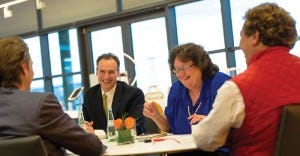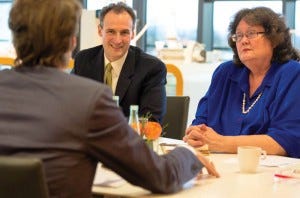Total Solutions Support the Growth of a Dynamic Industry: A Conversation with Reinhard Vogt and Stefan SchlackTotal Solutions Support the Growth of a Dynamic Industry: A Conversation with Reinhard Vogt and Stefan Schlack

Left to right: Stefan Schlack (senior vice president of marketing and product management, Sartorius Stedim Biotech), Brian Caine (publisher of BioProcess International), S. Anne Montgomery (editor in chief of BioProcess International),
and Reinhardt Vogt (executive vice president of marketing, sales, and services, administrative board member of Sartorius Stedim Biotech).
While attending a conference at Sartorius Stedim Biotech in Göttingen, Germany, BPI publisher Brian Caine and editor in chief Anne Montgomery spoke with Reinhard Vogt (executive vice president of marketing sales and services, and member of the administrative board) and Stefan Schlack (senior vice president, marketing and product management). They discussed Sartorius’s forward-thinking business strategies, its position as a total solution provider, and how the company’s strategic goals mesh with its assessment of current industry directions.
Single-Use As an Enabling Technology
Caine: Your company positions itself as a total solution provider for the biopharmaceutical industry, with a special focus on single-use applications. Can you tell us what impact single-use has had on the market and what the future holds for the technology?
 Vogt: For filter cartridges and capsules, single-use is quite an old concept. Today, though, single-use processes are much more complex and comprise part or indeed the whole production concept; they are replacing stainless steel containers and piping. However, it has taken a while for single-use to develop and for the solutions to become robust and scalable enough to operate at production level.
Vogt: For filter cartridges and capsules, single-use is quite an old concept. Today, though, single-use processes are much more complex and comprise part or indeed the whole production concept; they are replacing stainless steel containers and piping. However, it has taken a while for single-use to develop and for the solutions to become robust and scalable enough to operate at production level.
Assurance of Supply
Caine: Single-use technologies have reopened once-stalled markets, such as vaccines. As a total solution provider, how do you work with clients to assure them that Sartorius Stedim Biotech is the company that can take them from start to finish in their process?
Vogt: Single-use technologies have reached a quality level similar to stainless steel. Today, we offer a comprehensive technology and product portfolio. We source and monitor our raw materials, and we control the actual production of the single-use solutions as well. We bring our customers to our suppliers to ensure them that our suppliers’ quality-management systems match our quality system and that they can rely on it.
Caine: What about other applications for single-use technologies and other indications? Do you see applications for your technologies in cell therapy, for example?
Vogt: We’re watching the market carefully and have made some recent investments. We believe that we have an excellent portfolio already supporting this market. For example, our wave-style bioreactors are already used in this area, and very promising data have been published recently for our single-use, stirred-tank bioreactors. We’re also cooperating with Lonza, which has a lot of experience in this area with its contract manufacturing services.
 Montgomery: Where are we regarding the reality of completely single-use facilities?
Montgomery: Where are we regarding the reality of completely single-use facilities?
Schlack: Actually, this is already reality for quite a few of our customers. In this respect, one of our customers just received the ISPE “Facility of the Year” award for a completely single-use MAb process.We actually delivered the unit operations for upstream and downstream processing.
And we expect to see further significant activity especially driven by the so-called emerging economies. We believe that our industry faces four key challenges: capacity adaptation, smart process transfers, risk mitigation, and cost savings. For example, the Chinese biopharmaceutical market grows on average by 30% per year; some products grow by 70% or more. Fast capacity adaption will be a key success factor to meet the drug demand of the growing market. On one hand, it is important for our customers to avoid sunk costs due to underused capacity. On the other hand, they need sufficient capacity to secure market share. Especially for biosimilars, I believe that flexibility will be crucial and will be provided by single-use technologies
Another example is process transfer. When you put the right and scalable single-use technologies in your process development, you will be able to accomplish process transfers in 12 months or less. By contrast, process transfers based on stainless steel can easily take twice as long or even longer, depending on whether you have to build a new facility or adapt an existing one. No biopharmaceutical company can afford that amount of time: you have to be first to market to take full advantage of your patent or, in the case of biosimilars, take your share of the market.
We have developed very useful enabling technologies for single-use drug manufacturing facilities. For example, our new Virosart HF system is gamma sterilizable. You avoid sanitization, and at the same time you get an excellent virus filtration performance comparable with other market leading technologies. Another example is our FlexAct UD single-use solution for ultra- and diafiltration. It saves you up to six or more hours of preparation. This is especially critical when you think about product change-overs. Our customers typically look for solutions that reduce change-over times. Our membrane adsorbers are yet another example. They are easy to operate and fully scalable, so you don’t need to invest in installing large chromatography columns for your polishing steps.
Providing a Total Solution
Caine: In terms of single-use, how do you define being a total solution provider, and what are the main drivers and hurdles in that market?
 Schlack: We just talked about the challenges of the pharmaceutical industry. Single-use is a solution to address them. However, to offer a true alternative to stainless steel, we have to move away from focusing on components and individual products and offer complete single-use process steps. Using our FlexAct UD as an example, we provide a mixing bag, a mixer, vent filters, a controller, pressure transmitters and pumps, crossflow cassettes, a holder and a recirculation bag, a storage container and bag, as well as tubing. And all that has to be combined with application and process know-how to make it easy for our customers to use. Furthermore, our customers require assurance of supply and transparent change-control procedures for the single-use components of the process steps. Sartorius Stedim Biotech is capable of doing this. However, managing this complexity is certainly a challenge, and we are prepared to develop our company to adapt to it.
Schlack: We just talked about the challenges of the pharmaceutical industry. Single-use is a solution to address them. However, to offer a true alternative to stainless steel, we have to move away from focusing on components and individual products and offer complete single-use process steps. Using our FlexAct UD as an example, we provide a mixing bag, a mixer, vent filters, a controller, pressure transmitters and pumps, crossflow cassettes, a holder and a recirculation bag, a storage container and bag, as well as tubing. And all that has to be combined with application and process know-how to make it easy for our customers to use. Furthermore, our customers require assurance of supply and transparent change-control procedures for the single-use components of the process steps. Sartorius Stedim Biotech is capable of doing this. However, managing this complexity is certainly a challenge, and we are prepared to develop our company to adapt to it.
Vogt: A total solution means exactly that — a total solution — not just the supply of components and the availability of scalable products for each process step, but risk mitigation and logistics as well. Some customers are looking for upstream solutions, some are looking for downstream solutions, and others may want a total production solution, wherever they are in the world. Some want an entire single-use factory; others want a hybrid solution. Some want as much as possible to be single-use, but they might already have a 5,000-L stainless steel bioreactor. Sometimes, no single-use technology is available for a particular application. Our “total solution provider” strategy means that we understand what our customers expect from us: single-use products and integrated single-use process solutions, and perhaps most importantly, a partnership to jointly achieve the goal in the most effective way.
Montgomery: Talking about some of your single-use products, can you tell us a little more about your new Flexsafe bag concept and the new S80 polyethylene film?
Schlack: Sartorius Stedim Biotech has developed a new polyethylene (PE) film and family of bioprocessing bags to meet the single-use manufacturing needs of the future. Unlike any other film on the market used to make bags for biomanufacturing, our new S80 PE film, which is used in Flexsafe bags, is the result of close collaborations between Sartorius Stedim Biotech and our polymer and film suppliers. With this unprecedented partnership, we have developed a completely new polyethylene film structure and achieved excellent and consistent cell growth, robustness and unprecedented assurance of supply. With these unique benefits, Flexsafe enables the implementation of single-use bioprocessing throughout the entire drug manufacturing process: from development to production, from upstream to downstream, including cell culture, storage, shipping, mixing, and freezing and filling applications.
For example, take the issue of cell-growth inhibition in single-use bags. This is a major issue for today’s biopharmaceutical companies. What’s the cause? It is related to a cytotoxic degradation product derived from a commonly used antioxidant. To overcome this challenge, you need a deep understanding of polymer and material sciences in combination with cell biology. We have exactly accomplished this deep understanding in Flexsafe development.
Flexsafe ensures excellent and reproducible growth, even with the most sensitive production cell lines. Cell-growth reproducibility is guaranteed by controlling the resins and the additives specifications and by setting a design space for the film-extrusion parameters. Independent laboratories have demonstrated that Flexsafe bags are free of cytotoxic leachables. No known toxic degradation product of common additives (bDtBPP) is detectable in water-for-injection (WFI) extracts. Furthermore we’ve established a secure supply chain even down to the resin manufacturer, with long-term contracts and true partnerships. Business continuity is achieved with a robust contingency plan that includes backup resin crackers and film extruders, multiple bag manufacturing and sterilization sites and safety stocks of resins and film.
Caine: How does the BIOSTAT STR 2000 affect your portfolio, and how does it benefit your clients? Will bioreactors need to be developed above a 2,000-L capacity?
Vogt: With increasing titers, I don’t think that single-use bioreactors will need to go beyond 2,000 L. In some cases, that volume may not go above 1,000 L. Vaccine producers, for example, don’t need a 2,000-L fermentor.
Schlack: I can agree to that; 2,000 L will be the manufacturing scale of the future, especially considering recent developments regarding intensified fed-batch processes. But it’s equally important that you have a complete range. No customer buys a 2,000-L bioreactor from Sartorius Stedim Biotech and then another from a different supplier. You have to offer a complete range (2–2,000 L) so you can ensure straightforward and fast scale-up and scale-down, process transfers, and troubleshooting.
We also incorporate the same single-use sensors in each single-use bioreactor for complete comparability. We’ve worked hard to provide a complete upstream solution, which is why we acquired TAP Biosystems. The ambr15 multiparallel minibioreactor has already become the industry choice for cell line and medium development. The ambr250 system that we recently launched is based on the same design principles as conventional glass stirred-tank systems and our BIOSTAT STR single-use bioreactor. At the same time, it is a multiparallel process-development bioreactor system enabling effective and fast quality by design (QbD) studies to determine the operating ranges of critical process parameters and the design space of the production process.
Vogt: Imagine that you have a single-use process and a single-use fermentor, and you source tubing from one supplier, the filter from someone else, the controller from yet another company, and so on. And then, the components don’t fit together. Small, start-up companies aren’t in a position to manage multiple vendors and support FDA inspections based on this level of complexity. And large biopharmaceutical companies are looking for sourcing efficiencies as well.
Montgomery: Not to mention the challenges of monitoring the supply chain for each of those components.
Vogt: Yes, and we’re also trying to educate our customers about that.
Schlack: In process development, aspects such as assurance of supply, change control, and pricing security are not really critical. But when our customers move toward commercial production based on single-use processes, they become critical. Your manufacturing costs could significantly increase if those elements aren’t in place when you go into current good manufacturing practice (CGMP) production.
As Reinhard said, to reach this level of assurance of supply, standardization is needed. But standardization will be possible only when the biotech industry understands that is has to reconsider the R&D mindset of selecting bits and pieces from multiple different sources — such as tubings from vendor A, filters from vendor B, sensors from C and so on.
Vogt: If you don’t standardize a process, you can’t automate it. We need more standardization in single-use technologies to improve quality, reduce operator errors, and decrease costs. The bag is comparatively cheap, but putting all the components together is expensive.
To Partner or Acquire?
Caine: Having mentioned your association with SüdPack and the importance of collaborations, how do you decide whether to acquire or partner with a company? And how do you assess the value of one kind of relationship versus another?
 Vogt: First, we determine what we consider to be a component rather than a key technology. Our key technologies are cell culture, membrane and single-use technologies. Once we decide on a key technology, we need to develop or acquire it so that we have R&D and the whole manufacturing under control and can ensure a sustainable supply chain. Sometimes, however, we identify a key technology but cannot buy the company for whatever reason, or we might be interested in only 10% of a company’s portfolio. That’s when we think about cooperation models. A good example is our agreement with Lonza. We wanted a media offering, and we also wanted to work with a company that had many years of experience in that area, with products on the market and a good brand name. Lonza uses 80% of its media for its contract manufacturing organization (CMO) activities, so it made no sense for us to buy the remaining 20%. Instead, we created a virtual joint venture without capital or legal components. Lonza does the production and oversees logistics; together we handle sales, marketing and R&D; and at the end, we share the profits.
Vogt: First, we determine what we consider to be a component rather than a key technology. Our key technologies are cell culture, membrane and single-use technologies. Once we decide on a key technology, we need to develop or acquire it so that we have R&D and the whole manufacturing under control and can ensure a sustainable supply chain. Sometimes, however, we identify a key technology but cannot buy the company for whatever reason, or we might be interested in only 10% of a company’s portfolio. That’s when we think about cooperation models. A good example is our agreement with Lonza. We wanted a media offering, and we also wanted to work with a company that had many years of experience in that area, with products on the market and a good brand name. Lonza uses 80% of its media for its contract manufacturing organization (CMO) activities, so it made no sense for us to buy the remaining 20%. Instead, we created a virtual joint venture without capital or legal components. Lonza does the production and oversees logistics; together we handle sales, marketing and R&D; and at the end, we share the profits.
Montgomery: Acquisition is clearly an important part of your business strategy. Can you offer more background on the purchase of TAP Biosystems?
Schlack: We believe that TAP Biosystems is the final piece in our upstream portfolio. When you do QbD studies, you have to do multiple small-scale trials. There’s no better system available for that than the ambr250, which is truly scalable. We now can offer fully automated, multiparallel bioreactors, sensors and controllers, offering full scalability up to 2,000 L. So it’s a really complete package. I’m very glad that it’s now part of the Sartorius family.
Vogt: The acquisition became interesting when TAP Biosystems combined its automation expertise with single-use technology. TAP’s know-how regarding stirred microreactors enables automated process optimization and the unparalleled development of cell lines for biopharmaceutical production by reproducing classical bioreactor conditions. The combination of automation and single-use is unique, and multiparallel process development translates into enormous time and cost savings for customers.
The Future of Process Analytical Technology (PAT)
Caine: Let’s switch to another important topic. During the conference, we’ve heard a lot about process analytical technology (PAT), QbD, and design of experiments (DoE). What do you think is the key to their successful adoption and commercialization?
 Schlack: Our vision is to offer seamless transfer from process development to commercial production in upstream processing. We are very close to reaching this point. The TAP Biosystems acquisition, together with our chemometrics offering, was crucial in this respect because it lays the foundation for QbD approaches and effective process optimization and characterization in a very short time frame.
Schlack: Our vision is to offer seamless transfer from process development to commercial production in upstream processing. We are very close to reaching this point. The TAP Biosystems acquisition, together with our chemometrics offering, was crucial in this respect because it lays the foundation for QbD approaches and effective process optimization and characterization in a very short time frame.
Caine: What’s more important: technological advancement or additional education on existing technology?
Vogt: Both. Unlike the mature chemical industry, the bioprocess community is still on a learning curve. Our strategy has always been driven by finding out what our customers need, not what they want. That’s a big difference. If you were asked 20 years ago whether you needed a smart phone, you might have said no. Today everybody uses them. That’s a good example of need versus want.
Schlack: Timing is also important. It’s often not about reinventing the wheel, but rather offering a complete solution. In our industry, you have technology adoption cycles of six to eight years or more, so you have to believe in your analysis of future trends — and keep on investing — even if you don’t immediately get a good return on that investment.
Company Growth, Sustainability
Montgomery: Can you speak about planning for the future, how you recruit and train new staff?
Vogt: That’s very important for us. We have a very good staff retention rate and good training programs. But I think it’s also about company culture and giving young people a chance. You have to create a culture of appreciation and encouragement that goes beyond the framework of typical talent management.
Schlack: We need openness and room for people to gain experience. We have excellent people. As managers, we have to ensure that they can share their knowledge and exchange ideas. Of course, it helps to have a dynamic company in a vibrant market. We send people all over the world, which encourages them to develop their skills and expertise and keeps them loyal to the company. To lose people is to lose potential.
The Take-Home Message
Caine: Given that your market-facing statement for Sartorius Stedim Biotech is to be a total solution provider, what message are you trying to send to the market?
Vogt: First, customers should know that if they want to incorporate single-use processes, they should come to us! We have invented it, we are the market leader. And, of course, we go beyond components, technologies and applications into supply chain management. So customers can review our assurance of supply and business continuity plans. The other key message is that we have added products to our portfolio because we want to be best in class. We want to be the best in cell culture, in downstream processing, in filtration, and so on.
Schlack: We want to be a partner for the biopharmaceutical industry. We offer solutions that address key industry needs and challenges. And we work hard to close the final remaining gaps.
Reinhard Vogt is Sartorius Stedim Biotech’s executive vice president of marketing, sales, and services and a member of the company’s administrative board. Stefan Schlack is Sartorius Stedim Biotech’s senior vice president of marketing and product management. Both are based in Göttingen, Germany. Brian Caine is cofounder and publisher, and S. Anne Montgomery is cofounder and editor in chief of BioProcess International, amontgomery@ bioprocessintl.com.
You May Also Like





